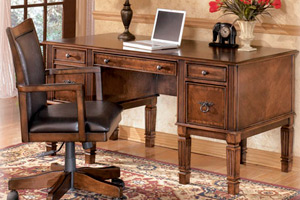
Bài viết muốn cung cấp cho quý vị những thuật ngữ tiếng anh ngành nội thất và nó được giảng giải chi tiết cặn kẽ bằng tiếng anh. Mỗi chi tiết của đồ nội thất bằng tiếng anh sẽ giải thích cho quý vị biết đặc điểm nhận dạng của từng bộ phận và cấu tạo của đồ furniture. Trong bài viết có một số hình ảnh minh họa cho quý vị hiểu rõ hơn về từng bộ phận của đồ nội thất.
Acanthus leaf:Used in classic Greek and Roman decoration, this popular 18th century motif is favored by Chippendale. Carvings of this Asian-native plant appear on cabriole legs and moldings.
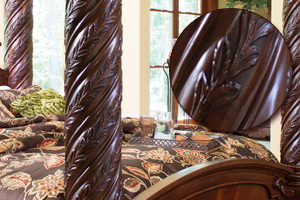
Accent colors: Contrast colors used to spice up room schemes
Abbreviation for Above Finished Floor. This is typically used on construction plans to note installation heights or objects.
Accent lighting: Decorative lighting used to draw attention to chosen objects and create mood and highlights. i.e., track lighting, chandeliers, and sconces.
ADA Guidelines: A set of requirements applied to the design and construction of all buildings to ensure individuals with disabilities have full access to the building and its facilities under the Americans with Disabilities Act (ADA) of 1990.
Adaptations: Newly made furniture pieces that capture the flavor of the original but are not authentic.
Ambient Lighting:Main overhead lighting in a space providing a diffused layer of uniform illumination
Antiquing: The process of making wood or fabric look old and used. This can be done through a finish, artificial weathering, or distressing.
Applique: French for “applied.” Ornaments such as carvings, turnings, lozenges, etc., which are tacked or glued to a surface rather than cut from the solid wood.
Apron: Boards that are placed at right angles to the underside of a tabletop or seat of a chair, extending between the tops of legs. On case goods furniture, it is the perpendicular face below the lowest drawer between bracket feet.
Arabesque: A kind of scroll pattern in which leaves, flowers, fruit and geometric forms are intertwined
Armoire: French term for a wardrobe frequently used to describe a French-style wardrobe.
North Shore Armoire
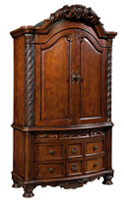
Art Deco: Style of architecture and furnishings popular in the 1920’s and 1930’s; characteristics include streamlined, geometric motifs expressed in materials such as glass, plastic and chrome.
Art Nouveau: Forerunner of Art Deco; style of decoration between 1890 and 1910 characterized by flowing lines, sinuous curves and forms derived from nature.
B
Bachelor’s Chest: A small low chest of drawers which first appeared in the 18th century.
Back Splat: A section of flat, occasionally pierced wood in the center of the back of a chair
Back orders: Items on a purchase order with insufficient inventory to satisfy demand.
Balance
A state of equilibrium; can be symmetrical or asymmetrical. Arrangement of objects around an imaginary central point to achieve a pleasing result.
Ball and claw: A turned food of spherical form with a carved bird’s claw clutching the ball. Inspired by ancient Chinese figures of a dragon claw holding a jewel
Balloon back: A chair with a circular back resembling a balloon; popularized in Victorian times.
Banquette: A long bench-like seat, often upholstered and generally built into or along a wall.
Bas relief: A sculpture or carving whose design projects a little from the surface.
Blanket Chest: A low storage chest with a hinged lid and often a lower drawer, serving also as a bench.
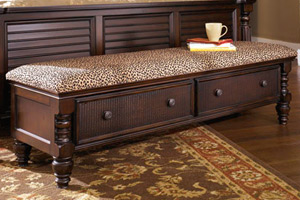
Key Town Blanket Chest
Beading: Decorative detail resembling a row of flattened beads.
Bentwood chair: A chair popularized in Paris café culture made from wood bent using a steaming process.
Bergère: An upholstered French armchair with outwardly rolling arms and sections of its wooden frame exposed.
Bleaching: The process of chemically treating wood to provide a lighter, more uniform color.
Bolster: A long, often cylindrical, cushion or pillow for a bed, sofa, etc.
Bombe: (Pronounced Bombay) A low, usually heavily decorated chest of drawers with outwardly bulging front and sides.
Bonheur Du Jour: A delicate 18th century French ladies writing desk having a small glazed cabinet on top.
Bonnet top: Also called a Hooded or Dome top. A full dome or curved, covered top section.
Bookcase Headboard: A headboard for a bed that has space to store books, radios, clocks, and other small items. Sometimes called a storage headboard.
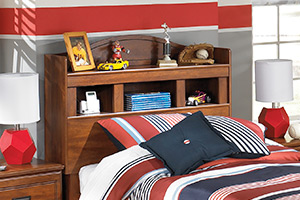
B228 – Bookcase Headboard
Book Match: A method of veneer matching where pairs of adjacent slices of veneer, as they are cut from the log, are opened up like the pages of a book, producing a mirror image of the grain pattern.
Bow front: Outwardly bowing front of an item of wooden furniture.
Box Match: A veneering pattern similar to diamond match and angled to create a series of consecutive squares radiating out from the center.
Brace Block: A piece of wood or metal, fitted into an angle of a piece of furniture to add strength or rigidity.
Bracket foot
A foot resembling an “L” on its side placed at the corners of cabinet furniture.
Breakfront: An item of furniture divided vertically into three sections, with the center section projecting forward.
Broadloom: Carpet woven on a wide loom.
Brocade: Used in fine, formal upholstery, it has raised surface patterns resembling embroidery.
Broken pediment: A decorative feature placed at the top of an item of furniture, which resembles a camel’s hump. The center section of the hump is removed (hence the term “broken”) to make room for additional ornamental features.
Buffet: A buffet/sideboard without a hutch or storage cabinet on top. The French definition of the word is “a small sideboard; a place to keep dishes.”
Bun Foot: A foot shaped as a slightly flattened round ball typically used on chests of drawers or upholstered chairs.

Brennville Chest – Bun Foot
Bureau: A desk built on top of a chest of drawers. The desk is revealed when a flap or “fall” is lowered. Occasionally a bookcase sits on top of it.
Burr veneer:A veneer specially cut from a log to produce a highly figured, wavy pattern.
Butler’s tray: A wooden tray with high sides and handles, which sits on top of a table or folding trestle. Occasionally made with folding sides which, when lowered, creates an oval shape.
Butt Joint: This is a type of joint where wood ends meet perpendicularly at right angles without overlapping or notching.
Butt Match: Veneer arrangement similar to book match, but joined end-to-end in a continuous strip. This may also be called end match.
Butterfly Table: A small folding table with splayed legs generally turned. The top has wing brackets underneath to support drop-leaf wings on either side.
Cabinet furniture: Generic name given to storage furniture.
Cabriole leg: A table or chair leg with a gentle “S” shape which curves outward at the top and then curves inward while tapering gradually. Named after an early French term for “goat” (literally “goat’s leg”) it is common on Queen Anne and Chippendale style furniture. Occasionally referred to as a Queen Anne leg.
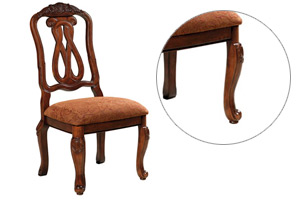
Cabriole Leg
Camel back: Used to describe furniture with a curve like a camel’s hump along its back.
Candelabra: A large, branched candlestick.
Canopy: Literally meaning a “roof”, as created over either a four-post bed or protruding outwards like a hood from an item of cabinet furniture.
Capital: The uppermost part of a column or pilaster, which crowns the shaft; often decorated.
Cartouche: The French word for cartridge, this refers to a scroll-like ornament, often an oval shape which was frequently used as the central motif in a design, and sometimes in a corner of a coved cornice.
Casegoods or Case Pieces: Furniture industry term for chests or cabinets.
Casters: Small wheels mounted on a swivel frame and then attached to a base or legs to facilitate moving a piece of furniture.
Canterbury: A portable magazine rack.
Cedar Chest: A rectangular storage chest made of sold cedar or cedar veneers to prevent moth damage on woolens.
Center Match: An arrangement of two veneer sheets of uniform size, matched in the center on a single face. Also called balance match.
Chairback Headboard: This is an open headboard style resembling the back of a dining room chair.
Chaise Lounge: An upholstered settee with an arm at one end and a back that tapers down to seating level.
Chamfer: To bevel and edge.
Checkerboard Match: An arrangement of small squares of veneer with their grain lines alternating in direction, producing a checkerboard effect.
Chenille: Fabric with thick needle-punched design; often used on bedspreads and robes as well as casual upholstery.
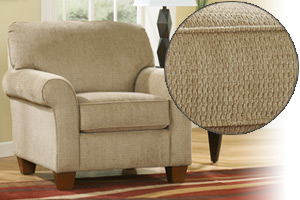
Chenelle: Chest on chest
A large chest of drawers on which sits a slightly smaller chest of drawers.
Chesterfield: A leather settee with deep-buttoned upholstery and large rounded back and arms.
Cheval Mirror: A long freestanding mirror that swivels through its center to enable full-length viewing.
China Cabinet: A cabinet with a glass front and typically sits on a buffet or shallow cupboard.
Chinoiserie: Painted or lacquered furniture using designs drawn from Chinese art.
Chintz:Printed cotton fabric, frequently glazed, used in country or casual decoration.
Chippendale: Name applied to Thomas Chippendale’s eighteenth-century furniture designs, including the camelback sofa and the wing chair.
Classic: Refers to design based in the artistic standards, principles and methods of the ancient Greeks and Romans.
Coffee Table: A long, low table used in front of a sofa. Also called a cocktail table.
Coffer: A storage chest having a hinged lid.
Combing: A decorative paint technique that gives a wall a look of age and depth by layering or ‘washing’ increasingly thinner coats of paint over one another.
Commode: Small, low chest of drawers.
Complementary colors: Colors that are opposite each other on the color wheel (i.e. blue and orange).
Concept: A comprehensive idea or generalization that brings diverse elements into some basic relationship.
Core: The inner layer of plywood or particleboard in veneered panels.
Corner Block: Triangular wood block used in the concealed structure under tabletops, inside cases, and at points of stress on upholstered furniture frames.
Corner-breaking: Taking the sharp edges off the corners on moldings, drawer fronts, doors, etc.
Cornice: Decorative section of wood that runs along the top of cabinet furniture and leans out at an angle to provide a pleasing finished appearance to the piece.
Couch: Also called a sofa; it is an upholstered seat typically for more than one person.
Coving: A curved molding connecting the ceiling and wall.
Credenza: A buffet, sideboard, or bookcase, especially one without legs. A piece of office furniture having a long flat top.
Crossbanding: A veneer banding in which one layer of veneer runs at a right angle to the next layer in order to offset shrinking, swelling, and warping.
Curio Cabinet: An enclosed glass cabinet for displaying a variety of products such as glassware and other collectibles. Sometimes simply called a curio.
Cutwork: Embroidered fabric with decorative cut-out designs that are outlined in a buttonhole stitch.
Cyma Curve: A simple double-curved molding with a reversed curve as its profile. Derived from Greek meaning, “wave”.
Gaylon Bookcase – Cyma Curve
Damask: Formal fabric with textural contrast between satiny and dull.
Daybed: Similar to a bed but narrower and with a padded seat back at one end for leaning against.
Dentil molding: A decorative feature composed of rectangular blocks (“teeth”) spaced at equal intervals, typically along the length of a cornice. Favored in 18th century design.
Diamond Match: Four pieces of relatively straight-grained wood veneer cut diagonally then joined to meet in a central diamond shape.
Dinette: Small-scaled dining furniture with a table and four to six chairs designed for kitchen use, but also used in small dining areas.
Distressing: An antiquing process that makes new wood look old and used. Usually entails surface marks and indentations that are added during the finishing process. Dovetail- A type of joint generally used to join the front and sides of a drawer by having wedge-shaped projections on one piece of wood interlock with grooves in another piece of wood.
Diversity: Variety and multiformity. The opposite of unity and just a little adds interest. Too much can make a design chaotic.
Dowel: A round grooved wooden pin, peg, or rod that is fitted into the holes in two pieces of wood to hold them together.
Down: Soft, fluffy feathers from very young birds or from the undersides of older birds or fowl. This is used for stuffing pillows and cushions, often combined with polyester fibers.
Drawer Guide/Slide: These strips of wood or metal are placed under the center or on the outside of drawers to serve as a track on which they are drawn back and forth.

Gaylon Office Furniture – Drawer Guide / Slide
Dresser/Dressing table: An item of bedroom furniture consisting of a low table with drawers, usually with a kneehole and frequently having a mirror attached to the top.
Drop leaf table: A table with hinged leaves which can be lowered to save space when not in use.
Durapella® & Duraplush™
High-tech fabrics that consist of 100% MicroDenier polyester suede. Also called microfibers.
Durablend™: A polyurethane/leather blended upholstery.
Dust Panel
A thin, horizontal board between two drawers in a chest to diminish dust accumulation.
Eclecticism: A style in which furnishings and accessories of various periods and styles are deftly and harmoniously combined.
Edging: A method of protecting a veneer panel by applying a thin strip of solid wood, metal, or plastic at the edge of the panel. Also called banding.
Embossing: A type of design that is produced on a surface by hammering, stamping, pressing, or molding.
Embroidery: The art of working raised and ornamental designs in threads of silk, cotton, gold, silver, or other material, upon any woven fabric with a needle.
Emphasis: Directing special attention or effort to a specific object or area.
Enamel Finish: A coating of paint that can be brushed and sometimes rubbed to a high gloss.
End Table: Small side table that may be used at the end of a sofa or beside a chair.
Engineered Wood: Any restructured composite of wood, including oriented strand board, particleboard, and plywood.
Etagere: A free standing open cabinet having several shelves used for display purposes.
Shayneville Bookcase and Mercana Wall Clock – Etagere
Fall Front: The hinged front of a bureau that lowers to reveal the desk inside.
Fan Pattern: Width and evenness of paint coming out of spray gun.
Fauteuil: A French upholstered chair having open sides.
Faux: Literally French for “fake”, this term is used to describe things that appear to be of one material or finish, but in fact are not. An example is faux books where bookends are used to create the effect of a real library.
Fiberfill: A soft, synthetic material used as cushioning in upholstered furniture, bedding, and comforters. Polyester fibers are most commonly used.
Fiddle back: A back splat shaped like a violin, common in Windsor chairs.
Filigree: Ornamental openwork of delicate or intricate design that is usually done in gold or silver wire.
Finger Joint: A process by which the ends of pieces of lumber are machined and fastened together by using glue. The machined edge looks like a series of fingers. The objective is to reclaim short unusable pieces of lumber into longer useable pieces.
Finial: A small carved or turned ornament used to provide a decorative finish to a tall vertical piece such as a long case clock or bedpost.

Privilege Decorative Finials
Finish: A treatment that is applied to wood to protect the surface and to make it more durable and resistant to stains and burns, to accentuate the natural grain, to lighten or deepen the color, to make a dull or glossy surface, or to change the color completely as by painting, lacquering, polishing, antiquing, distressing, etc.
Fire Cut Veneer: A combination of straight-grain and heart figure veneer produced by slicing half of a log directly through the center or heart.
Flat packed furniture: Also called KD, flat-pack or self-assembly furniture. Refers to furniture that is to be assembled by the end user.
Flock: Short fibrous particles that are applied by various processes to the surface of fabric, paper, or wood to give the appearance and feel of velvet or suede.
Flip flop sofa: A Japanese-style bed consisting of a soft mattress placed on a wooden frame. Some models fold to create a settee.
Fluting: Shallow vertical grooves, usually parallel, used to ornament a surface. Often used on columns or pilasters in classical architecture.
Folk art: A broad category of handmade art objects, new or antique, that display a charmingly naïve, unsophisticated quality.
Footboard: A supporting piece at the foot end of a bed, sometimes decorative.
Form: Fills the space and defines the area. A good Visual Merchandiser will also look at the negative void areas as well. There are three basic categories for form; rectangle (rectilinear), the triangle (angular) and the circle (curved):
Rectangular form gives room sturdiness but can be monotonous if overused.
Angular/Diagonals are used to attract attention and imply motion. It can be used to increase size relationships.
Curved forms imply change and continuity. Using circles and pinpoint or drawn attention to objects.
Four Post Bed / Four Poster: A bed having a post at each corner supporting a canopy.
Four Way Match: A veneer pattern produced by the combination of book matches and butt matches.
Frame: The supporting structure of a piece of furniture.
French Provincial: A term describing countrified versions of formal French furnishings of the seventeenth and eighteenth centuries; often referred to as “provencal” today.
Fretwork: Interlaced ornamental woodwork, usually in a complicated repeating, geometric pattern. This is often used in backs of chairs, beds, in china cabinet doors, or on table aprons and legs.
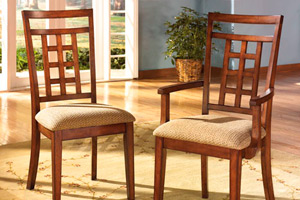
Cross Island dining room chairs – Fretwork
Frieze: A heavy pile of upholstery and drapery fabric with rows of uncut loops. Usually made of mohair, wool, cotton, or man-made fibers.
Fringe: A decorative border of thread, cord, or the like, usually hanging loosely from a raveled edge or separate strip.
Futon: A folded mattress on a frame that can be folded up for seating or down to form a sleeping surface.
Gate Leg Table: A drop-leaf table whose leaves are supported by extra legs that swing outwards like gates.
Gesso: (Pronounced jesso) A decorative feature created out of plaster commonly used on picture and mirror frames. Frequently finished by gilding or painting.
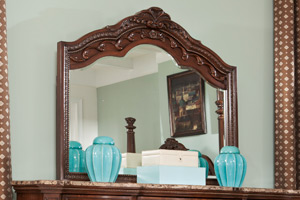
Ledelle Bedroom Mirror with gesso top
Gilding: A technique for applying gold to furniture and other surfaces.
GMROI
Gross margin return on investment. A calculation that clarifies how much gross margin is made on a piece of furniture compared to how much inventory is needed in stock.
Grain: Variations in color and texture made by the size and arrangements of cells and pores of a living tree and is revealed when wood is cut through the trunk in an essentially horizontal direction.
Grommet: A plastic, metal, or rubber ring that is inserted into a hole made through another material. They may be used to reinforce the hole, to shield something from the sharp edges of the hole, or both.
Gusset: Frequently used to fuse any number of load-bearing columns with beams or trusses together. The members can be bolted, riveted or welded to the gusset. Their function is critical to the integrity of the structure they are supporting.
Hardware: A generic term used to describe any metal fitting that goes onto furniture i.e., handles, locks, hinges, escutcheons, etc.
Harmony: The feeling created when tools are used together to provide a look that is pulled together.
Hardwood: A general term for the lumber of broad-leafed or deciduous trees in contrast to evergreen or coniferous trees, which are termed softwoods.
Hassock: A stuffed cushion used for a footstool or ottoman.
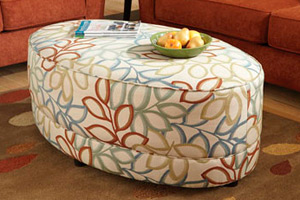
Corson Hassock
Headboard: A panel rising above mattress at the head of the bed. Often supports the bed rails.
Heat Transfer Printing: The technique of printing a fabric by transferring a printed design from paper onto fabric via heat and pressure.
Highboy: A high chest of drawers, deriving its name from haut bois, which is French for “high wood.”
Homespun: Originally, this was a fabric loomed by hand at home, but now the name of a loose, coarsely woven, power-loomed fabric that uses textured and bulky yarns to create a hand-woven look.
Hope Chest: Synonymous with a cedar chest and dowry chest.
Hue: The common name of a color. It indicates the color’s position in the spectrum or in the color circle. It is determined by the specific wavelength of the color in the ray of light.
Hutch: A two-part case piece that usually has a two-door cabinet below and open shelves above, originally dating from seventeenth-century England.

Wataskin and Larimer Server & Hutches
ILD (Indentation Load Deflection): Method for testing and measuring the firmness of latex foam. The test and measurement is done to a 4” x15” x 15” piece of foam placed on a flat surface. Then a round metal plate, 8” in diameter pushes down on that piece of foam. The amount of pressure, measured in pounds that it takes to compress the foam 25% (to 3”) is referred to as the ILD. The greater the number the firmer the foam. Ashley Sleep uses various latex foams ranging between 14 and 28 ILD.
Illumination: Impacts the perception of space, form, line, texture and color by creating shadows and color. The intensity of hue will be affected by illumination. Strong dark colors absorb light while light tints reflect light.
Inlay: Veneers of contrasting colors cut into decorative shapes and set into the surface of wood furniture for ornamentation.
Innerspring Mattress: A mattress with a center core of springs for buoyancy and resilience. A protective pad surrounds the springs.
Iridescent: Brilliant, lustrous, or colorful in effect or appearance. In fabrics it is a changeable effect due to the color arrangement in the warp and filling yarns to provide contrast and interest.
Jacquard: A formal, highly decorative fabric that includes damasks, tapestries, brocades, and all cloths with elaborate figures woven on a jacquard loom.
Japanning: A technique for decorating furniture which involves coating it with a hard, often black, lacquer and then applying oriental designs.
Joint: When making furniture, this would be the junction at which two pieces of lumber unite to form a support or make a closure.
Kiln Dried:Wood that has been dried in a control-heated chamber, as opposed to air dried, and is more likely to warp because the drying is less even.
Knee Hole:A space beneath a desk or dressing table designed to accommodate a person’s legs to enable them to sit comfortably when using the top as a work surface.

Hamlyn home office desk with knee hole
Knitted Fabrics: Fabrics that are formed by knitting. The interlocking of loops of yarn rather than interlacing two sets of yarn as in weaving.
Knock Down Furniture: Also called KD, flat-pack or self-assembly furniture. Refers to furniture that is to be assembled by the end user.
Lacquer: A durable varnish applied in several layers to protect furniture’s surface. Finishes can vary from matt to glossy.
Ladder Back Chair: A style of country chair with horizontal slats in the back that resemble a ladder.
Laminate or “Lam”: Applied covering to boards, which provide different appearances such as colors and grains (see also paper, vinyl). A synonym for “replicated.”
Lattice: An openwork crisscross or fretwork made of thin, flat strips of wood or metal. Usually found on chairs and headboards.

Home Accents Lattice Mirror
Lazy Susan: A revolving tray or stand of wood or metal.
Leaf: A board or panel that is used as a tabletop extension. Some leaves are hinged to the table surface and must be raised to a horizontal position, as in a Pampero or gate-leg table. Other leaves are drawn out from beneath the table surface, as in the draw table. In other tables, the top can be separated and extended so leaves can be placed in the opening.
Leather Match: Upholstery that features top-grain leather in the seating areas with skillfully matched vinyl everywhere else.
Line: Works with form to emphasis or outline a space or materials used in a space. Horizontal lines can be used for a more relaxed look and to emphasis the length of a wall or item. Vertical lines added formality and height to an area.
Lissere: A delicate, multi-colored jacquard woven floral stripe.
Long Care Clock: Also referred to as a grandfather clock. A clock housed in a tall wooden case containing weights and a pendulum.
Loveseat: A two-seated sofa.
Lowboy: A small table with drawers on cabriole legs.
Mantel: The complete facing around the opening of a fireplace, including any shelf used above it as well as any part that projects from the wall.
Marquetry: Heavy use of inlays over a large surface to create a panoramic picture.
Mattress Ticking: The fabric that covers a mattress.
Medallion: A round or oval ornamental motif.
Medium Density Fiberboard (MDF)
This is made by breaking down wood chips into fibers, mixing glue, and fusing the resulting mixture under heat and pressure to produce a board.
Miter: A surface slanted to another surface, it is called a miter when the angle is 45 degrees.
Modular: Furniture constructed in units that can be arranged in different configurations.

Key Town modular entertainment wall
Modular Carpet: A round or oval ornamental motif.
Moire: Fabric, usually silk, with a rippled, wavy pattern that gives a watered appearance or wood grain. It has a very traditional appearance.
Molding: Decorative strips of wood applied to furniture for visual effect.
Monochromatic Scheme: A color scheme limited to one color in various tones. The value and intensity of the hue are used to provide contrast. This color is often simple and sophisticated.
Mortise and Tenon Joint: Method of joining two pieces of wood where the projecting tenon of one piece fits into the opening (mortise) of the other.
Motif: A decorative design or subject.
Motion Furniture: Chairs, beds, or sofas containing mechanisms that allow the user to recline or extend their legs.
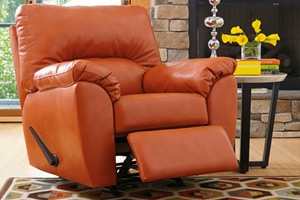
Kaylor DuraBlend Recliner – Motion Furniture
Mount: Ornamental metalwork applied to furniture – usually cabinet pieces, sometimes chairs.
Muslin: This is a plain-weave fabric that may be bleached or unbleached. Usually used as undercovering on upholstered pieces to tie in the stuffing and padding materials prior to putting on the final upholstery fabric.
Neoclassic: A revival of the classic style and form.
Nightstand: Occasional table, sometimes with cabinet, drawer, or shelf, used beside a bed to hold such items as a lamp, clock, or telephone. May also be called a night table or bedside table.
Non-woven: Fabrics that are produced by the bonding or interlocking of fibers, or both. The non-woven fabric is made by mechanical, chemical, thermal, or solvent means, or with an adhesive, or any combination of these, as distinct from weaving, knitting, or tufting.
Occasional Furniture: A generic term used to describe small pieces of furniture such as lamp tables, coffee tables or magazine racks.
Olefin: A synthetic fiber that is extremely light, soil resistant, and an excellent insulator. This is often used to produce outdoor carpets and sturdy upholstery fabrics resistant to abrasion, pilling, and aging.
Ottoman: A long, low upholstered seat with no back: used with a chair as a footrest. If over scaled, can be used in place of a cocktail table.
Palette: A term used by artists and designers to describe a range of colors.
Panel:A surface set off from the surrounding surface by being raised, recessed or framed.
Parquetry: Furniture inlaid with geometrical designs similar to parquet floors.
Parson’s Table: A square or rectangular table with wide, straight legs.
Particle Board: Panels that are manufactured by bonding wood particles with synthetic resins under heat and pressure. Used as the core for many plywood panels, as panels to be printed (engraved), or other uses in furniture construction. Also called fiberboard, chip core, hardboard, and medium density fiberboard.
Patina: The coloration and texture, which wood and leather acquire with age and use.
Pattern: A repetitive component to a surface that can be used to modify scale, color or texture. They can be used to unit or clash with other items. Be very careful when working with multiple patterns.
Pedestal Table: A table supported by one or more cylindrical columns or “pedestals”.
Pediment: A decorative crest found at the top of tall pieces of furniture to achieve a pleasing finish.

North Shore entertainment center with pediment
Pembroke Table: A small rectangular drop leaf table.
Perspective: A means of showing a solid object on a surface so as to make it appear to have a third dimension. To make it convincing to the eye, sizes of distant objects are reduced; parallel lines tend to converge.
Pickled Finish: The result of rubbing white or off-white paint onto previously stained and finished wood.
Piecrust Table: A table, usually with a round top, that has an edge that is raised, scalloped or fluted; frequently a tilt-top table.
Pier Mirror: A tall mirror designed to be hung above a pier table.
Piercing: Decorative detail achieved by cutting shapes through thin wood such as chair splats.
Pilaster: A flattened column-like detail applied to furniture, bookcases, etc. as a decorative feature.
Pile: This is cut or uncut loops that stand up on the face of a fabric, making it thick and three-dimensional, in contrast to flat-woven cloth.
Pillow Shams: Covers for pillows to match bed coverings, when pillows are propped on top of the bed.
Plain Weave: This is a basic weave in which the warp and weft are the same size and alternate under and over each other in a regular manner.
Platform Bed: A mattress that sets on the top of a wood or plastic platform or pedestal. Sometimes the mattress may recess into a frame on the top of the platform, and there is a shelf that may go partially or completely around the perimeter.
Plenum Space: An enclosed space in buildings, typically between the roof deck and suspended grid ceiling, used for heating, ventilating, and/or air-conditioning airflow.
Polyester: Parts made from pressed wood and sprayed with polyester material.
Plywood
A structural material made of very thin layers of wood bonded together with the grain of each layer, or ply, at right angles to that of the next.
Polyfoam: This is a synthetic resin that simulates latex foam rubber and is used for upholstered furniture, pillows, mattresses, etc.
POP: An abbreviation for Point of Purchase. Associated with tags and showroom signage.
POS: An abbreviation for Point of Sales.
Potboard: An open shelf at the bottom of a piece of furniture traditionally used for storing pots and pans.
Pot Cupboard: A small bedside table which in times past housed a ceramic bowl or “pot”.
Pouf: A low upholstered stool of solid construction.
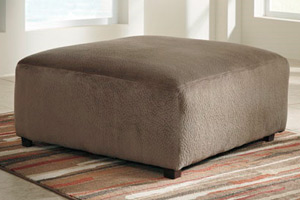
Jessa Place Ottoman – Pouf
Primary Colors: Red, blue and yellow, from which all other colors are derived.
Print: A surface having a pattern imposed with ink or dye by means of stencils, rollers, blocks, or screens.
Product Association: A process in which lamps, rugs, bed linens and/or accessories are coordinated with Ashley product. This process is supported by the tagging system and national advertising.
Pull: A handle to open drawers or doors of cabinets.
Profile: The style of an edge.
Proportion: An agreeable or harmonious relation of parts within a whole; balance or symmetry.
Queen Anne Leg: A table or chair leg with a gentle “S” shape which curves outward at the top and then curves inward while tapering gradually. Named after an early French term for “goat” (literally “goat’s leg”) it is common on Queen Anne and Chippendale style furniture. Occasionally referred to as a Queen Anne leg.
Queen Anne Leg
Quilted Fabric: Two layers of fabric that has padding between the layers, held in place by stitches that usually follow a definite pattern.
Quirke: A narrow groove channel separating molding from adjoining members.
Rabbet Joint: A joining technique for supporting shelves or drawer bottoms in vertical units. The edge of the vertical piece of wood fits into a groove in the horizontal piece. Also known as a dado joint.
Rail: A generic term used to describe a long section of wood serving a functional purpose in furniture. Examples are the top rail in the back of a chair and the rails, which connect the headboard and footboard of a bed.
Random Match: In veneering and decorative surfacing, a casual, unmatched effect with no attempt at a symmetrical or a repetitive pattern.
Reeding: Close, parallel rows of convex moldings. The opposite of fluting.
Relief: A carved decoration, which stands proud of the surface on which it appears.
Reproduction: New furniture which is a copy of an antique.
Restoration: Work carried out on furniture to bring it back to its original condition.
Retro: A setting, furniture pieces or decorative element that revives a style or look of the past.
Return: The part of an L-shaped desk that is at right angles to the main work surface, providing additional workspace.
Reverse Box Match: A decorative veneer technique similar to a reverse diamond match, and aligned to create a cross-patterned center with right-angled patterns going off in four directions.
Reverse Diamond Match: Four wedges of wood or veneer set together to form an X at the center with consecutively smaller V’s radiating out from the center in all four directions. May also be called butterfly match.
Rhythm: The alteration of strong and weak elements to create movement. We want the eye to travel around an area.
Roll Top Desk: Desks with a tambour cover which rolls back to reveal the writing surface.
Rotary-Cut Veneer: A slice of veneer made by cutting a log in a circular manner around the circumference. A bold, variegated grain is then produced because the cut follows the log’s annual growth rings.
Runner: A rail used to support additional leaves on an extending dining table.
Rush
A variety of sea grass that is used to weave chair seats or a long stem of marsh-growing plant.
Sateen: A strong, lustrous, satin-weave cotton fabric. May be bleached, dyed, printed, or made with woven patterns.
Scale: A term referring to the size of objects in relation to each other.
Sectional Furniture: Upholstered furniture composed of complementary sections that can be grouped in a variety or arrangements or used separately.
Secondary Colors: Colors produced by mixing two primary colors, such as yellow and blue to form green; red and yellow to form orange; and red and blue to form purple.
Secondary colors are green, orange, and purple
Secretaire: A sideboard with false drawers that drop forward to reveal a desk and work surface.
Self-Assembly Furniture: Also called KD, flat-pack or self-assembly furniture. Refers to furniture that is to be assembled by the end user.
Semainier: A tall, narrow seven-drawer chest introduced in the Louis XV period, with one drawer for each day of the week. Also called a lingerie chest.
Serial Numbers: Numbers that identify product (i.e., identifies vendor and manufacturer).
Serpentine Front: An item of furniture that has a curved front that is first concave, then convex before becoming concave again.
Serving Table: A long narrow table with drawers.
Settee: Another word for a sofa.
Settle: A rustic wooden bench having a high back and solid arms. The seat is often hinged to reveal storage space beneath.
Shade: The darker values of a color obtained by mixing the color with black.
Shaker Design: Furniture made by the Shaker religious sect, noted for its functional simplicity, austere beauty and fine workmanship.
Sheen: In wood finishing, this is a degree of luster of a dried film.
Shield Back Chair
A chair in the Hepplewhite style having a back in the shape of a shield.
Short Rail: Displaying a bed’s headboard and footboard using 6 inch rails.
Sideboard: A buffet or a credenza. A long, waist high piece of furniture used for serving food. The most common arrangement is cupboards below and drawers above.
Side Chair: A chair with a small seat (15 to 18 inches wide) and no arms.
Annora Side Chairs
Sisal: A strong natural fiber originally used for rope; now often used to make rugs; sometimes blended with wool in carpet.
Skirt: A fabric valence around the base of an upholstered chair, sofa, etc., to hide the legs and wood construction of the seat.
Slat: Any thin, flat section of wood. Examples are bed slats which are used to support a mattress and horizontal back slats in a ladder back chair.
Sleigh Bed: A popular French Empire-style bed having a high scrolled headboard and footboard, creating the impression of a sleigh or a boat (also called “lit bateau” or “boat bed”).
Slip Cover: A removable fitted cover made to protect upholstery fabric, cover worn upholstery or to provide a change for a new season.
Slip seat: A removable, upholstered chair seat.
Sofa: Also called a couch; it is an upholstered seat typically for more than one person.
Sofa Bed: A generic term referring to a variety of sofas with mechanisms that allows them to convert from a sofa to a bed. Also called a sofa sleeper or convertible sofa.
Softwood: Wood from an evergreen tree such as the pine with needle-like, scale-like, or coniferous leaves.
Space: Interior space is the shaped volume defined by various architectural forms such as ceiling, floors, walls and other architectural elements. A Designer will evaluate and use tools to define structure and alter it.
Spindle Back: A chair having vertically arranged spindles in the back.
Splat: A flat, vertical piece of wood found in the center of a chair back.
Staining: For wood finishing, this is the process of applying coloring matter to the outer surfaces of wood to enhance the grain, provide uniform overall color, or to imitate or match other cabinet woods.
Stretcher: A horizontal arrangement of rails used to connect the legs on tables and chairs to provide structural strength.
Stylized: A design that has been done according to the rules of a style rather than according to nature.
Sunburst: Figured wood grain in which rays radiate outward from a central point. Also called pie match.
Symmetry: Formal balance created by arranging objects so they form mirror images on either side of an imaginary line that goes through the middle of a grouping of objects.
Taffeta: A medium-weight or light-weight fabric of acetate, nylon, rayon, or silk, usually smooth, crisp, and lustrous, plain-woven, and with a fine crosswise rib effect.
Tambour Door:A flexible door that can be concealed by rolling it into a piece of furniture.
Tapestry: Thick woven fabric with pictorial design.
Task Lighting: Lighting needed to perform a specific task. i.e., desk lamp.
Tassel: A pendent ornament consisting commonly of a bunch of threads, small cords, or other strands hanging from a round knob or head, used on clothing, in jewelry, on curtains, etc.
Tester Bed: A bed having two posts at the headboard supporting a half canopy above.
Texture: The characteristic of a material that can be felt or seen. You can achieve the perception of texture by lighting and the surface materials of the items. Smooth, shiny surfaces make objects clean and brighter in color. Those surfaces also emphasis the outline of the object. Rough surfaces tend to absorb sound and light and tend to give off a warm feeling.
Ticking: A striped cotton or linen fabric, originally used for mattress covers but now used decoratively, as well.
Tilt Top Table: A small, often round table with a hinged top, which can be raised when not in use.
Tint: The lighter values of a color obtained by mixing the color with white.
TOB: An abbreviation for Top of Bed. Ashley TOB sets contain a comforter, pillow shams, and a bed skirt.
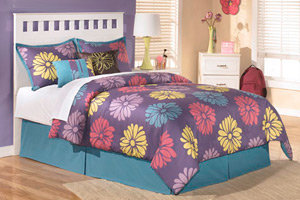
Top of Bed – Bedding
Tone: The darkness or lightness of a color; different colors may be of the same tone.
Tongue and Groove: A flush wood joint in which a long, straight projection of one board fits into a corresponding groove in another board.
Torchere: The French word for candelabra. These are often large, sometimes standing on the floor. A floor lamp that directs the light upward.
Trestle Table: A rustic rectangular table with a top supported by two wide boards or “trestles” at either end. The two trestles are joined by a single stretcher.
Trompe l’oeil: (Pronounced tromp loi) Literally French for “trick the eye”, a painting which cleverly uses shadow and light to create the appearance of a three dimensional object.
Trundle Bed: Pullout bed on casters somewhat smaller than the bed under which it is set.
Tufting: An upholstery technique where the covering fabric and the padding are tied back in a definite pattern, creating small “pillows” between depressions.
Turning: An ornamental or structural part of furniture made by rotating a cylindrical piece of wood on a lathe and shaping with cutting tools.
Twill: Tightly woven with a diagonal ridge such as denim or herringbone fabrics.
Unity: The combination of elements to support a concept. It is achieved through the repetition of elements such as color, pattern or shape. Unity is a narrower definition of harmony.
Upholstery: Generic term used to describe any item of sitting furniture that is covered in fabric.
Uprights: Term used to describe any vertical structural component i.e., “The uprights in the back of that chair”.
Velour: This is a soft pile upholstery fabric, generally woven in a satin weave or plain weave, resulting in a short, thick pile.
Velvet: Formal elegant fabric with fur-like feel and a cut pile.
Velveteen: A pile fabric often of cotton or rayon with a short, nappy surface.
Veneer: A thin layer of wood cut from a log in such a way as to maximize the beauty of the grain pattern. Veneers are then glued onto a solid substrate, which is then made into furniture. The result is sturdy furniture with a decorative outer appearance.
Vinyl
Another type of laminate that is thicker and more durable than paper laminate (see also “laminate”).
Vitrine: French term for a display cabinet with glass doors.
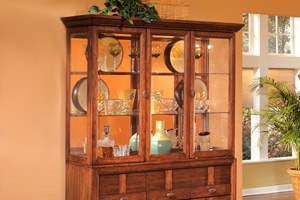
Clifton Park Vitrine
V Match: Veneer cut and butted together to form a decorative pattern in which the wood grain radiates from the centerline to form a pattern resembling a series of V’s set one over the other.
Wainscoting: Wood paneling applied to walls from baseboards to the desired height, usually about one-third of the way up a wall.
Wall Washers: Angled down lights which bathe the wall surface in light.
Weave: A process of making fabrics by interlacing warp threads with weft or filling yarns.
Webbing: Strips of tightly woven plastic, nylon, rubber, elastic, or metal used in upholstery construction as a support for, or in place of, springs under the cushions.
Welting: A fabric-covered cord sewed into the edge seams of upholstery where a firm, defined edge is needed as for a box shaped cushion.
Wet Wall: The wall where plumbing fixtures are located.
Wheatear: A decorative motif resembling an ear of wheat.
Wicker: Strong woven matting of willow, reed, or rattan cut into different diameters then used to construct furniture, often for outdoor use.
Windsor Chair: A popular 18th century wooden chair having a solid seat and a back formed from a bent wood hoop and vertical spindles.
Wing Chair: An upholstered armchair with a high back from which lateral head rests, or “wings”, protrude on either side.
Yarn Dyed: Fabric where the yarn is dyed before it is woven or knitted.
Its not my first time to pay a visit this web site, i am browsing this web page dailly and obtain fastidious data from here every day.